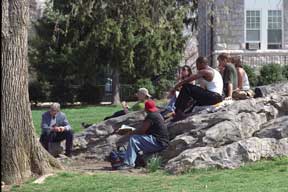
For nearly 50 years, Madison was all about women. Despite the fact that men had attended since the beginning and that many had managed to graduate with teaching degrees, Madison College was one of Virginia's four women's teachers colleges.
Men first enrolled as day students in 1910, during the Normal's first summer session. Alongside 207 women, about 14 men registered as day students, a situation that remained largely unchanged for nearly 40 years.
Except for two brief periods, 1927-29 and again in 1940 when men lived in campus housing for the summer sessions, male students commuted or found local housing.
In 1946, following World War II, men were first admitted to regular sessions of Madison College under the G.I. Bill, a reluctant concession by the state board of education at the request of the Veteran's Administration. In 1947, more than 100 men enrolled.
That year men formed a basketball team, the Madison Dukes; organized touch football teams; and established a fraternity, Sigma Delta Rho. Though still a significant minority, men made their presence known. They joined the staff of The Breeze, formed a men's student organization and performed with the Stratford Players.
Throughout the 1950s, Madison men studied at the pleasure of the legislature. Early in that decade, however, even that was in jeopardy. On the last day of the 1950 General Assembly, a bill allowing men to enroll in any curriculum, not just teaching, was defeated. Two years later, when the legislature had still not remedied the situation, Miller, according to historian Dingledine, “faced the possibility that Madison might have to stop accepting male students.”
Miller went to bat for the men, arguing that their presence on campus benefited the college. He also contended that many local men would have no other way to attend college. Madison needed men, he believed, and men needed Madison.
Unwilling to upset the status quo, legislators continued to limit male enrollment. Men registered as day students, but in order to remain after two years, they were required to enroll in teacher training programs.
Miller, who had designated coeducation in his inaugural address as necessary and attainable, was not satisfied. His administration promoted men as an integral part of the school.

In 1953, the Alumnae Association became the Alumni Association to recognize the growing number of male graduates. Dormitory space was again offered to male students enrolled in summer school. Miller appointed the first male student to the fee committee and strengthened the men's student government association.
Despite these efforts, however, and faced with limited opportunity to acquire only four-year teaching degrees, male enrollment declined.
Miller would not be deterred. Neither would society.
Throughout the 1950s, Madison College was evolving. An influx of new faculty members, liberalized social regulations - many student-driven - and a new American post-war attitude about opportunity and education compelled change.
Finally, in 1966, Miller's inaugural dream came true when Virginia's General Assembly decreed that men could attend any of Virginia's teachers colleges as full-time students and pursue any degrees they wished. Madison College was coeducational.
-- Martha B. Graham
